
Satan-II – the formidable Russian Inter Continental Ballistic Missile (ICBM) has the enviable reputation of being the biggest, heaviest, and fastest weapon system in the world. It is rightly called the ‘Mother of all Missiles’ in the world.
A tradition of producing the ‘greatest of them all‘ arms
Since the Second World War, the Russians have a long list of such marvels of weapons engineering, which are truly ‘neighbour’s envy, owner’s pride’. These include the Kalashnikov AK-47 rifle and its derivatives, with some 150 million of them produced in the world. The M-16/M-4/AR-15 family of assault rifles in the USA comes a distant second with some 20 million produced. Post-WWII, two of their tank designs, namely, T-54/55 and T-72 saw the production of about 100,000 and 42,000 pieces respectively. American Patton tanks came way down at 15,000.

They produced the world’s still fastest fighter jet Mikoyan-Gurevich MiG-25 Foxbat that was capable of a scorching speed of Mach 3.2 (3524 kmph). Although the American F-104 Starfighter was the world’s first fighter to cross Mach 2 it was highly prone to accidents and had earned the nickname of ‘Widowmaker’. On the other hand, the Russian MiG-21, introduced a little later, also crossed Mach 2 but was so reliable that over the decades a record 13,996 of them were built, with the American F-16 that also touches Mach 2, coming second with some 4,600 of them produced.
They also produced the world’s largest and heaviest combat aircraft, the fastest strategic bomber in use and the largest and heaviest variable-sweep wing aircraft ever flown, the Tupolev Tu-160 Blackjack Mach 2+ bomber. Its maximum take-off weight is 606,000 pounds compared to the American B-1B Lancer’s 477,000 pounds. Their Antonov An-124 is the world’s largest military transport aircraft (max. payload 150 tons) compared to the USA’s C-5 Galaxy (max. payload 127 tons).

They produced the world’s largest nuclear submarine, the Typhoon class which displaced about 23,000 tons on surface, compared to 16,500 tons of the USA’s Ohio class subs.
Coming to conventional bombs, when America made the GBU-43/B MOAB (Mother of all Bombs) with a yield of 11 tons of TNT, Russia responded by producing the Aviation Thermobaric Bomb of Increased Power FOAB (Father of all Bombs) with a yield of 44 tons of TNT.
To top the list, they also exploded the world’s biggest hydrogen bomb Tsar Bomba, with a yield of 58.6 megatons, compared to the USA’s largest bomb Castle Bravo at 15 megatons.

The ‘mother of all missiles’
Russian State Space Corporation Roscosmos chief Yury Borisov announced on September 1 that Russia has placed its latest ICBM, the RS-28 Sarmat (NATO designation SS-X-29/30, popularly called Satan-II in Western media), on ‘combat alert posture’. The missile was introduced during a 2018 Russian State-of-the-Nation address and President Putin hailed it as a “next-generation” missile capable of beating any ballistic missile defence system in the world. The first successful test launch of the missile was conducted on April 20, 2022, from the Plesetsk Cosmodrome in the Arkhangelsk region. After the test, Roscosmos CEO Dmitry Rogozin called the missile a “gift to NATO” and announced on live TV that Russia was starting production of 46 units of the missile.

The test had taken place just months after Russia had invaded Ukraine. Putin had warned at the time that the missile would “give thought to those who are trying to threaten Russia”. Many in the West had thought it to be just a bluster or, at best, ‘sabre rattling’ intended to divert attention from the setbacks in Ukraine. However, to their utter dismay, Russia went on to announce in November 2022 that the missile had entered serial production. Then on June 21, 2023, Putin reiterated that the Sarmat strategic complex would be ready to take up combat duty in the near future.
The missile’s most extraordinary features are its blistering speed, unprecedented range and the capability to penetrate anti-ballistic missile defence systems. Many in the West believe that this missile would replace the existing R-36 (NATO designation SS-18 Satan) and that’s why they are calling it Satan-II.
Inception of the programme
The idea of this missile was mooted way back in 2011 by the Makeyev Design Bureau and they started preliminary work on this ground-breaking weapon. However, the Euromaidan or Maidan Uprising of November 2013 in Ukraine forced Russia to sever its collaboration with Ukraine’s military-industrial complex. The protests were sparked by then-Ukrainian President Viktor Yanukovych deciding to choose closer ties with Russia even as the parliament had overwhelmingly approved of finalizing the European Union-Ukraine Association Agreement. It led to the so-called Revolution of Dignity, culminating in the ouster of President Viktor and the outbreak of the Russo-Ukrainian War. Once the ties were severed, Russia accelerated work on it. In February 2014, the date of deployment was projected as 2020. Problems came on the way but were gradually overcome.
How does it compare with other ICBMS of the world?

The first is its sheer size. It is the heaviest of them all. The Satan-II weighs 208.1 tons. On the other hand, the USA’s workhorse silo-based missile LGM-30 Minuteman III weighs 36 tons. The heaviest ICBM that they had fielded, the now-retired LGM-118 Peacekeeper ICBM, weighed 88 tons. China’s latest Dongfeng DF-41 missile weighs 80 tons. India’s Agni-V is, according to sources in the public domain, about 50-56 tons.

The DF-5 ICBM of China, though 183 tons heavy, is not really comparable to Satan-II. First, there is a generation gap in technology with the DF-5 being a much older second-generation ICBM. Second, it is not a true silo-launched missile. It is stored in a horizontal tunnel dug into a high mountain for protection from nuclear attacks. It is moved out in the open from the tunnel for fuelling and firing, the operation taking about two hours, during which they remain highly vulnerable.

The Satan-II stands 35.5 m (116 feet) tall, which makes it nearly 11 storeys high. The Minuteman-III is 60 feet tall. The DF-41 is 69 feet. The DF-5 is 107 feet. The Agni-V is a little over 57 feet.

Then the Satan-II has an enormous range of 18,000 km. Its predecessor, the SS-18 Satan had a range of 16,000 km. The Minuteman-III has a range of 14,000 km whereas both the DF-41 and DF-5 have a range of up to 15,000 km. Agni-V is said to have a range of 7-8,000 km.
The most striking feature of the Satan-II is its huge payload of 10 tons. The Satan had a payload of 8.8 tons. The Minuteman-III has a payload of just about a ton and the Peacekeeper had a payload of 4.4 tons. China’s DF-5B can carry 5 tons, whereas DF-41 carries 2.5 tons.

The missile’s accuracy is claimed to be a CEP (Circular Error Probable) of 500 m, which compares well with other ICBMs, though somewhat less than the CEP of 240 m of the Minuteman-III. The missile is guided by inertial guidance, GLONASS (a satellite navigation system similar to the American GPS), and Astro-inertial guidance systems.
Satan-II– terrifying payload
The missile’s payload is terrifying. It can carry 10 to 15 MIRV (Multiple Independently Targetable Re-entry Vehicles) warheads of 750 kilotons each, 16 smaller ones, a combination of warheads and countermeasures, or three hypersonic Avangard hypersonic glide vehicles.
Compare this with the Minuteman-III, which carries three MIRV W87 warheads (300 kilotons yield), whereas the Peacekeeper could carry 10 of them. The DF-41 is said to be capable of carrying 10 MIRVs of 150 kilotons each.

It is also equipped with the Mozyr Active Protection System, designed to negate the enemy’s first strike advantage by discharging a cloud of metal arrows or balls kinetically destroying incoming bombs, cruise missiles, and ICBM warheads at altitudes of up to 6 km.
Technical features of the Satan-II missile
The Sarmat/Satan-II is a liquid-fuel missile like its predecessor the Satan. In comparison, the Minuteman-III and the DF-41 are solid-fuelled missiles. Only the DF-5 is liquid-fuelled.
The Satan-II is fired using a solid-propellant ejector, PAD (Propellant Actuated Device) or gas generator, also known as the ‘mortar method’. This acts essentially like the propellant in a gun cartridge, producing gases at very high pressure, which pop up the over 200-ton heavy missile to a height of some 20 meters above the ground. The PAD itself separates from the missile’s aft section as it clears the silo when the missile’s main engine is fired.
The three-stage missile is powered in the first stage by four PDU-99/RS-99 liquid fuel engines (derived from RD-274/264/263 family of engines used on the SS-18 Satan missile), burning nitrogen tetroxide (NTO) and unsymmetrical dimethylhydrazine (UDMH) in the oxidizer rich staged combustion cycle. The 208.1 tons heavy missile carries 178 tons of fuel. Together, they developed more than a million pounds of thrust, compared to 178,000 pounds thrust of in the first stage of the Minuteman-III missile.

A significant feature of the Satan-II is that it consumes fuel very quickly, developing very heavy thrust in the active stage of the flight when its engines are firing. The ignition gases of the rocket engine exhaust are so hot that orbiting satellites can pick up their heat signature and confirm that it was indeed a missile launch. Then they start tracking its trajectory to guess its likely target and prepare missile defences accordingly. A short engine burning time reduces the time period in which enemy satellites could detect its heat signature and thus make missile defence difficult.
Given its tremendous range of 18,000 km, the Sarmat/Satan-II can make circumterrestrial flights and hit targets on the other side of the planet from unexpected directions, all within an hour. Halfway around the planet is a little over 20,000 km. In its test flight in April 2022, it had taken just 20 minutes to travel 6,000 km and hit the target in the Kura range in Kamchatka.
What are hypersonic glide vehicles?

In early 2018, Russia sent shockwaves around the world when President Putin, in his Presidential Address to the Federal Assembly, announced six novel nuclear or dual-use weapons systems, popularly called ‘super weapons’ (superoruzhie in Russian). They include the Avangard hypersonic glide vehicle (HGV), Burevestnik nuclear-powered cruise missile, Zircon scramjet-powered anti-ship hypersonic cruise missile, Kinzhal hypersonic air-launched ballistic missile, Poseidon unmanned underwater vehicle, and the Sarmat/Satan-II ICBM.
Also Read: Are we living in the age of missile warfare?
The US is understandably scared because the HGVs do not fly on ballistic trajectories like a conventional ballistic missile. Conventional ballistic missiles have fixed, uncontrollable parabolic trajectories of projectile motion. This makes it theoretically possible for an anti-ballistic missile system radars and computers to track and predict the trajectory for firing the ABM (Anti-Ballistic Missile).

The HGVs, on the other hand, are always under control and hence, they are manoeuvrable. Manoeuvrability means that their flight path becomes essentially unpredictable. The manoeuvring is three-dimensional—longitudinal skip, lateral waving and lateral turning modes. This is achieved through controlling fins and aerodynamic forces.
It is believed that Avangard develops speed up to Mach 27 and certainly more than Mach 20. The glide vehicle is some 18 feet long and 2 tons heavy. China has also developed an HGV DF-ZF (earlier called the WU-14) though it has a lower speed of Mach 10 and it does not carry a nuclear warhead like the Avangard. The Russian HGV carries nuclear warheads of 0.8 to 2 megatons.
Why is USA scared of Satan-II?

The Satan-II missile could very well sound the death knell for the USA’s ambitious and extremely expensive ballistic missile defence program called NMD (National Missile Defense), which has consumed $44 billion so far and has been the Pentagon’s costliest project in history! With the ‘super weapons’ Russia effectively answers the American threat of Prompt Global Response (PGS) concept that proposes pre-emptive conventional massed cruise missile strikes to disarm an adversary and eliminate its leadership.

